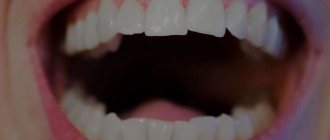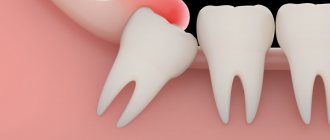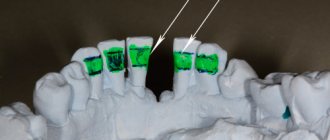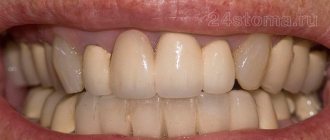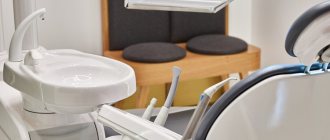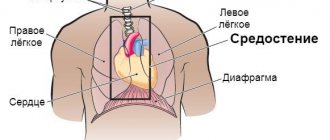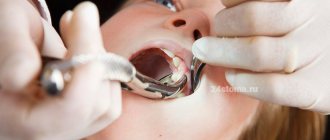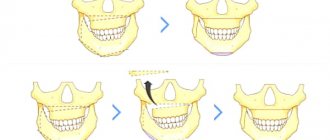There are plenty of reasons why you can lose a completely healthy tooth in our lives. In adults, the face, and along with it the jaws, are often injured in road accidents, as a result of falls, bad habits, and sometimes attempts to sort things out by force. Even more “opportunities” open up for children who love active games on playgrounds and sports grounds. In dentistry, this situation is usually called tooth dislocation.
Practice shows that many erudite adults get lost in such situations and don’t know how to behave. Meanwhile, you can save a tooth if you get an appointment with a dentist within an hour.
Diagnosis of tooth trauma
In case of tooth injuries, timely assistance is very important to minimize the consequences of damage. It cannot be put off until later (after a day, a week, etc.) - it is important to provide yourself or your child with first aid correctly and contact a dentist as soon as possible. But first you need to figure out what damage is considered a tooth injury.
Mechanical tooth trauma is damage resulting from falls, impacts, accidents and other external influences. They violate the shape of the tooth and the integrity of dental tissues. Mechanical injuries of various types are divided into acute and chronic dental injuries. The first type includes damage to teeth as a result of a single and strong action (falling from a bicycle, swing, scooter, biting too hard food or a toy, a blow to the teeth due to an accident, etc.).
Chronic injuries are associated with bad habits (for example, chewing pencils, pens, seeds) or with a violation of the closure of teeth, due to which the dental tissues are gradually injured.
➢ The peak of injuries to permanent teeth occurs at primary school age - 8-10 years, and for milk teeth - at 2-3 years.
➢ Injury to permanent teeth is less common among professional athletes, since they wear special protection - helmets, mouth guards, and shields.
➢ Most often, injuries occur for everyday reasons: during breaks at school, during active games, at home, on the street, etc.
➢ Trauma to the front teeth, especially the incisors, is the most common occurrence (about 80% of cases).
➢ The risk of damaging teeth is 3 times higher in people with a distal bite, in which the front teeth protrude forward and the lower jaw is in a posterior position.
The result of dental prosthetics
The patient is completely satisfied with the result of the treatment; in her opinion, her teeth began to look even better than before the accident. For a detailed commentary from the patient, as well as the opinion of all the specialists who took part in the treatment, see the video.
The work was completed by:
- S.V. Zukor is the chief physician of Dial-Dent, an orthopedic dentist. Work planning, dental prosthetics.
- V.P. Alaverdov is an implant surgeon at Dial-Dent. Removal of a broken tooth, dental implantation, gum microsurgery.
- D.V. Wolf is a dental technician, ceramist at Dial-Dent. Manufacturing of ceramic crowns, veneers, lumineers.
- E.P. Smirnova is a hygienist at Dial-Dent. Hygienic support at all stages of treatment.
See other examples of complex treatment and dental prosthetics from Dial-Dent specialists here.
Classification of dental injuries
The ICD-10 (International Classification of Diseases) classification of dental injuries includes more than ten types of dental injuries. To summarize, all mechanical damage is divided into:
- for injuries to the tooth itself or fractures;
- tooth displacement or dislocation;
- damage to soft tissues and jaws.
It is also worth noting a bruise - minimal damage to a tooth when it looks intact and visually no damage is visible - no chips, no cracks. But due to the impact, the blood supply to the tooth pulp may be disrupted, and subsequently the tooth may darken. Tooth bruises belong to the first class of injuries according to ICD-10. It hurts to touch, bite and chew food.
First aid for a bruise is to give pain relief if necessary, and consult a dentist as soon as possible.
If the tooth or its fragment could not be found
Even in this case, after an injury you need to visit a doctor as soon as possible to exclude complications:
- fragments of roots and fragments of hard tissue may remain in the hole, and they need to be removed and the wound treated;
- if only a fragment of the crown has broken off, it is necessary to carry out treatment as quickly as possible, to close the pulp in order to prevent its infection and inflammation;
- Correct treatment of the hole and timely treatment will simplify subsequent implantation and prosthetics if the patient decides to replace a lost tooth.
If the wound has torn edges, the bleeding does not stop, the mucous membranes are seriously damaged, the doctor will apply stitches. For rapid healing, the DentoSpas clinic can use APRF technology - the formation of a fibrin clot, which accelerates tissue regeneration. Additionally, the dentist may prescribe antibiotics and other medications to speed up healing, eliminate the risk of inflammation, and relieve pain. If tooth injuries are associated with contact sports, it is easier to prevent them by using special protective mouth guards. You can order their production at DentoSpas dentistry.
Dental injuries in the form of fractures
Chips of enamel, fractures of the coronal part with damage to the pulp, fractures of the roots - all these injuries fall into the category of “tooth fracture”. There are 3 options for fractures of primary teeth:
- if the baby tooth is slightly injured, then the doctor usually monitors its condition;
- In case of significant damage, the baby tooth is removed in order to preserve the permanent tooth germ, since the injured baby tooth becomes a source of infection. This often happens with longitudinal fractures - when the tooth cracks in half lengthwise, and it is no longer possible to save it;
- in other cases, the tooth can be saved through restoration and canal treatment. In young children, treatment is often carried out during sleep.
First aid for a tooth fracture: It is very important to collect all the tooth fragments and put them in water or milk. If you collect all the parts of the tooth and quickly, within half an hour, get to the dentist, the tooth can be restored and it will be successfully fixed in the socket. If it was not possible to collect the tooth particles, then treatment of the tooth injury is carried out:
- In case of minor damage to the enamel (chips, cracks), tooth polishing is not performed - the dentist restores the tooth by installing a filling.
- If there is severe damage to the crown of the tooth, endodontic treatment may be required to preserve the pulp and then the installation of an inlay and/or crown.
- If the root is fractured, the tooth is rigidly splinted for 3-4 months, and the dentist monitors the condition of the pulp. Sometimes it is necessary to treat the canal of a coronal fragment, but there is no need to connect the fragments with pins. The tooth can almost always be saved, since this is a sterile injury, and the treatment prognosis is favorable, and therefore it is not necessary to remove teeth with a broken root.
The peculiarities of dental prosthetics in children are the impossibility of using implants, so a lost tooth is replaced with a removable plate, an artificial tooth is fixed with fiberglass to adjacent teeth, or orthodontic mini-screws are used to fix the prosthesis with a temporary screw. Tooth replantation is also used - transplantation of a lateral tooth in place of a missing one.
How does a doctor restore a tooth?
If the tooth is intact, the doctor will suggest replantation. To begin with, radiography is performed, followed by the following procedures:
- Thorough antiseptic treatment of the oral cavity as a whole.
- Installing the unit in its original place. Localization is not carried out visually, but with the help of repeated x-rays.
- The edges of the hole are sutured.
- To secure the unit in position, a dental splint is required.
- The victim is sent home and antibiotics, anti-inflammatory drugs or painkillers may be prescribed.
- After a couple of days, you need to visit the dentist again. The healing of the tooth is assessed.
- If necessary, the doctor adjusts the splint.
- Complete engraftment will not occur quickly; it usually takes from 3 to 6 months. During the specified time, the unit remains mobile, so you should be especially careful and follow all medical recommendations.
- After final healing, the splint is removed.
Dislocation
When a tooth is dislocated, sometimes it is impossible to completely close the mouth, or the tooth becomes loose and changes its position relative to other teeth. How to distinguish a tooth dislocation from a fracture? If the appearance of the teeth has changed - they have become shorter, tilted, etc., and the gums are bleeding, then you are dealing with a dislocation.
First aid for dislocation is the most correct tactic: do not let the child close the teeth, do not touch them and do not try to set them back on their own, because such displacements can be accompanied by injuries to the bone and gums. It is best to immediately contact a dentist, who will take a three-dimensional photograph, return the teeth to the correct position, and apply dental plaster for several weeks. The sooner you do this, the better.
Experts distinguish between many types of dislocations, including partial, complete and impacted.
Partial dislocation
With such damage, the tooth partially falls out of the socket. Often the alveolar wall is damaged, there is a tear in the periodontal fibers, and therefore the tooth becomes loose, bleeding occurs, and severe pain occurs when pressing and chewing. However, the anatomical structure is not disturbed, so the main task is to fix the tooth in the correct position in the socket until healing. In case of partial dislocation, this is achieved using special caps or splinting. The key point is to get the victim to the dentist as quickly as possible.
Complete dislocation
The tooth completely falls out of the socket, which is accompanied by heavy bleeding. When a baby tooth falls out, it is not reinserted, since placing the baby tooth in the socket can damage the germ of the permanent one. But if a permanent tooth falls out, then the necessary first aid is to find the tooth, wash it with water, but do not rub it or treat it with alcohol, since there are still living cells on it. Then the tooth needs to be inserted into the socket or, if this is not possible, put the tooth in milk and call the clinic to get instructions on how to do this.
If the tooth is placed back into the socket within 5 minutes, the prognosis is favorable - the tooth will successfully take root. Over a period of 5 to 10 minutes, the chances decrease as the number of living cells decreases. If the tooth has been exposed to air for a long time and has dried out, it will not take root for long, just a few years.
In any case, you need to get to the clinic as soon as possible - preferably within half an hour. If this is not possible, then contacting a dentist is still necessary. It is necessary to carry out root canal treatment, since when a tooth is severely displaced or falls out completely, the blood supply to it stops.
Impacted dislocation
Milk teeth are very often driven deep into the socket, since when they fall, the impact force is directed from bottom to top. This is very dangerous for the buds of permanent teeth, which are located behind the roots of baby teeth. Due to such trauma, various disturbances in the formation of the enamel of permanent teeth can occur, which manifest themselves in the form of yellow and white spots or defects in the shape of the tooth. It is necessary to take a targeted picture on a visiograph to assess the risks for permanent teeth. If a baby tooth is impacted too deeply, it is removed to reduce the risk of developing defects in permanent teeth. Sometimes tooth reduction is performed, in which the dentist very carefully returns the impacted tooth to its correct position and then splints it.
Tooth injuries are often accompanied by damage to soft tissues - cheeks, gums, lips. In this case, the dentist prescribes mild antiseptics - most often chlorhexidine preparations, as well as a gentle diet without harsh foods.
First actions
If the tooth left its natural “habitat” unharmed, and you managed to find it, then you can count on the restoration of the unit. Find a small container, pour saline solution and place the tooth there. If you don’t have the necessary items on hand, you can wrap the unit in regular cloth or cotton wool. If possible, place a special cold pack next to the unit; it can be purchased at a pharmacy. In extreme cases, use ice.
If there is no heavy bleeding, it is enough to treat the oral cavity with any antiseptic liquid, Miramistin or Chlorhexidine will do. If there is severe pain, take any painkiller tablet, for example, Nise or Ketarol.
In case of heavy bleeding, you should immediately visit a doctor or call an ambulance.
Where to go with a dental injury
But if you have already provided first aid to a child or adult for a tooth injury, then why also contact a dentist? The fact is that there are damages that cannot be seen with the naked eye - for example, a fracture of the tooth root inside the bone, fractures of the jaw bones and the walls of the tooth socket. Even after successfully placing the tooth back into the socket, splinting is necessary - this is the temporary stabilization of the tooth using a wire that is attached to adjacent teeth. In some cases, it is necessary to suture the edges of the wound or prescribe antibiotics.
If you ignore the problem and do not consult a doctor on time (or do not visit the clinic at all), complications will arise. The tooth may darken, become mobile, and the most common complication after a tooth injury is pulp necrosis, in which the neurovascular bundle inside the tooth dies. The dentist uses special tests to determine the vitality and condition of the pulp. Leaving dead tissue inside a tooth can lead to tooth root resorption as the body begins to perceive it as a foreign body due to infection. This leads to tooth loss in a fairly short time. This is why it is very important to have your teeth examined by specialists after an injury.
Diagnostics
To assess the condition of the damaged teeth, doctors performed a computed tomography scan of the patient’s jaws. The first thing the doctors were convinced of was that the jawbone was not damaged. Tooth 11 broke off (the nerve was not damaged), tooth 21 was broken at the root and was held together only by the gums.
A tooth that is broken at the root cannot be saved. But to choose a restoration option, you need to remove the fragment and examine the condition of the root. Sometimes doctors use the root of a tooth to install a post and crown.
After removing a broken front tooth:
After removing the broken tooth, as well as studying CT scans and x-rays, doctors came to the conclusion that it would not be possible to restore the tooth using its own root. The fracture occurred too deep (below the gum level). It is necessary to remove the root of the broken tooth and place an implant. Implantation is the most reliable method of restoration if one tooth is missing, and Dial-Dent specialists have extensive experience in such work.
Commentary by the chief physician of Dial-Dent S.V. Tsukora: “To get a good result when implanting and prosthetizing anterior teeth, it is important to have a team of specialists working. Its obligatory participants are an implant surgeon, an orthopedic doctor and a dental technician. The more experience they have working together, the better the result will be. Our team has more than 10 years of experience.”
What to do if a tooth is knocked out: first aid
The possibility of restoration depends on whether you find the knocked out tooth or not. No matter how emergency the situation is, this must be done. It is advisable to place the found tooth in a jar of saline or contact lens solution. If these liquids are not on hand, then plain water, milk, etc. will do. Don’t have a suitable container to store your tooth? Wrap it in a piece of clean cloth and wrap it in a cold pack (available in any first aid kit). In winter, you can put the tooth in a bag of clean snow.
You should not try to insert the tooth yourself; by doing this you will injure the surrounding tissues. Reducing and fixing a knocked out tooth should only be done by a dentist. Attention! Do not touch the roots of the tooth, because you can get an infection. When teeth are knocked out, in most cases a laceration is formed and bleeding occurs. If you do not have problems with blood coagulation, then you do not need to take any hemostatic drugs. Simply soak a cotton swab in hydrogen peroxide and apply it to the bleeding hole. If you have severe pain, you can take a painkiller: Ketanov, Nurofen or regular Analgin.
